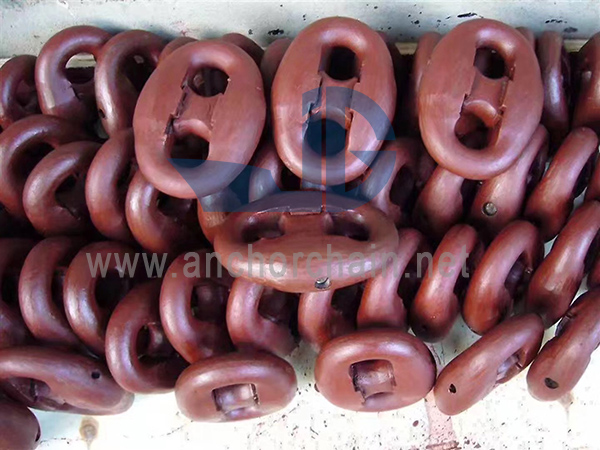Anchor Chain: The Unsung Hero of Maritime Safety
2025-03-07
When it comes to maritime safety and stability, the anchor chain plays a critical role. This often-overlooked piece of equipment is essential for holding ships in place, whether they are at dock, in harbor, or at sea. Understanding the importance and functionality of anchor chains can enhance safety measures for sailors and help maintain the integrity of vessels.
What is an Anchor Chain?
An anchor chain is a heavy-duty chain used to connect the anchor to the ship, allowing it to hold the ship in place. Made of high-quality materials, such as galvanized steel, anchor chains are designed to withstand the immense forces exerted on them when the vessel is anchored. These chains are engineered to be both strong and flexible, ensuring that the anchor can dig into the seabed and secure the ship, even in challenging weather conditions or rough waters.
Anchor Chain Components
An anchor chain typically consists of several important components:
1. Chain Links: The main body of the anchor chain is made up of interconnected metal links. These links come in different sizes, with larger links providing more strength and durability.
2. Kenter Link: A type of link used to connect two separate chains, providing flexibility and easy replacement if needed.
3. End Link: This is the final link that connects the anchor to the chain, and is designed for strength and safety.
4. Shackles: These are used to attach the chain to the anchor, ensuring a secure connection.
Importance of Anchor Chains in Maritime Operations
1. Stability and Safety
The primary function of an anchor chain is to provide stability to a vessel. Whether in port or at sea, a ship must be securely anchored to prevent drifting due to currents, tides, or wind. The anchor chain ensures that the anchor remains firmly in place, preventing accidents, collisions, or being carried off course.
For larger ships, including cargo vessels and tankers, the anchor chain is often critical in maintaining their position in the event of a storm or rough seas. Without a reliable anchor chain, a ship would be vulnerable to damage and could drift into dangerous waters, causing harm to the vessel, crew, and the surrounding environment.
2. Preventing Anchor Drag
Anchor drag occurs when the anchor fails to hold the ship in place, causing the vessel to drift. This is often due to poor anchor design, insufficient chain length, or rough seabed conditions. The anchor chain helps mitigate this issue by providing the right amount of slack and ensuring that the anchor is securely embedded in the seabed.
A good-quality, well-maintained anchor chain ensures that the anchor can hold its ground, even in challenging conditions. This is particularly important for offshore vessels and oil rigs, where the cost of losing position can be incredibly high.
3. Durability and Strength
Anchor chains are designed to withstand extreme conditions, including corrosion, abrasion, and heavy loads. The material used in anchor chains, typically high-strength steel or stainless steel, is selected for its durability and ability to endure the harsh marine environment. Galvanization or other forms of protective coatings help prevent rust and corrosion, ensuring the chain’s longevity and reliability.
Regular inspection and maintenance of anchor chains are crucial to ensure that they remain in good working condition. Worn-out or damaged chains can fail when needed most, leading to costly repairs and dangerous situations.
Types of Anchor Chains
There are various types of anchor chains used in different maritime operations, and the type chosen depends on the vessel's size, weight, and operational needs. The two primary types of anchor chains are:
1. Stud Link Chains: These chains are the most common type used in maritime applications. The links have protruding "studs" in the middle, which help prevent wear and increase the chain’s strength. Stud link chains are ideal for heavy-duty applications and are commonly used in large commercial vessels.
2. Chain Cable: This type of chain is used for lighter-duty applications and is typically found on smaller boats or vessels. It’s a less expensive alternative to stud link chains, but still provides reliable anchorage.
Choosing the Right Anchor Chain
Selecting the right anchor chain depends on several factors, such as:
- Vessel Size and Weight: Larger ships require stronger, heavier anchor chains to hold them in place securely. The size of the chain should be appropriate for the weight and size of the vessel to ensure effective anchorage.
- Seabed Conditions: The type of seabed in the area where the ship will be anchored plays a role in chain selection. Hard, rocky seabeds require more robust chains to ensure the anchor can embed properly.
- Environmental Conditions: In regions with strong currents, winds, or storms, it’s essential to use an anchor chain designed to withstand these forces. A heavier chain can help maintain the vessel’s position during adverse weather conditions.
Maintenance and Care of Anchor Chains
To ensure the longevity and performance of an anchor chain, regular maintenance is necessary. Proper care includes:
1. Inspection: Routinely check the anchor chain for signs of wear, corrosion, or damage. Look for any loose or missing links, as well as any links that have become stretched or weakened.
2. Cleaning: Keep the chain clean from debris, dirt, and marine organisms that can cause corrosion. After each use, it’s important to rinse the chain with fresh water and inspect it thoroughly.
3. Lubrication: Lubricating the chain can help prevent corrosion and reduce friction between the links, extending the life of the chain. Be sure to use marine-grade lubricants that are suitable for the marine environment.
4. Storage: When not in use, store the anchor chain in a dry, cool place to prevent it from being exposed to excess moisture or extreme weather.
Conclusion
The anchor chain may not always get the attention it deserves, but it is a vital piece of equipment that ensures safety and stability for ships on the water. Whether you are a boat owner, a fleet manager, or a sailor, understanding the role and importance of anchor chains is essential for proper vessel management and safety. By investing in high-quality chains, conducting regular maintenance, and using the appropriate type for your vessel, you can ensure your vessel is anchored securely in all conditions, providing peace of mind on every voyage.



